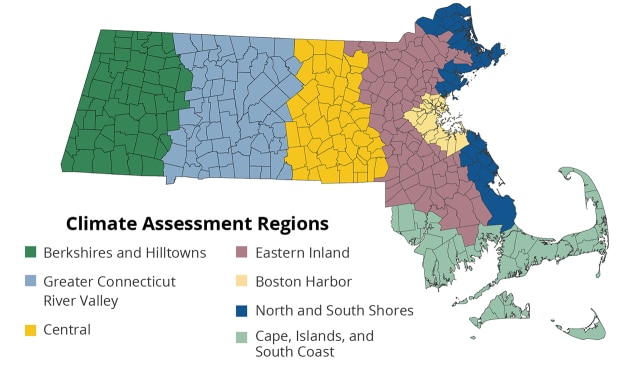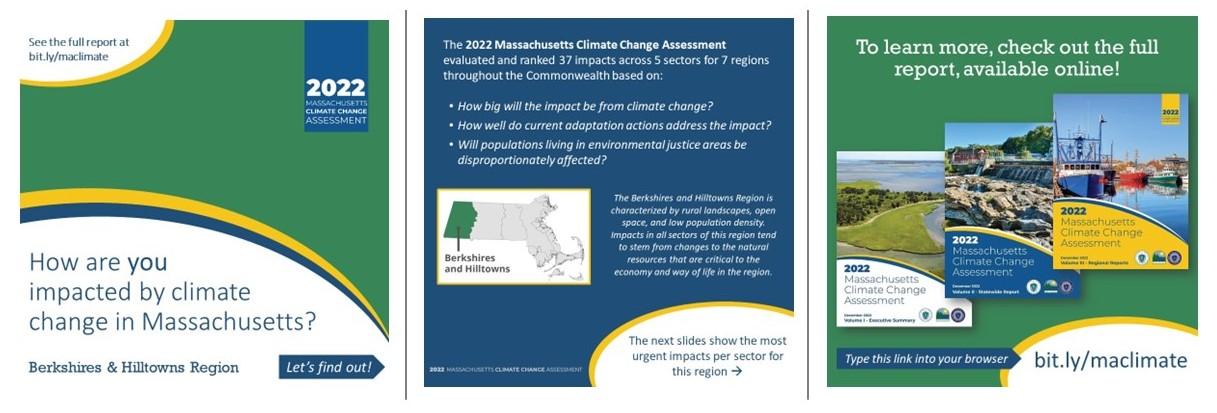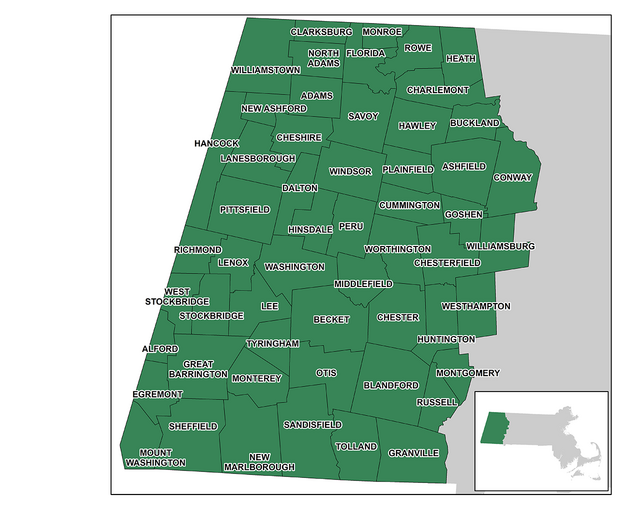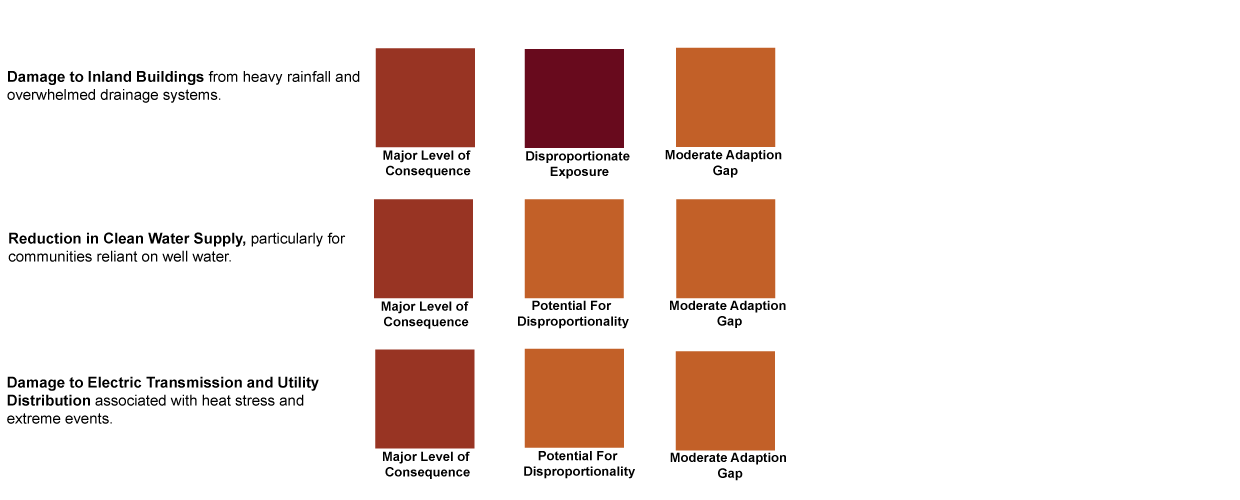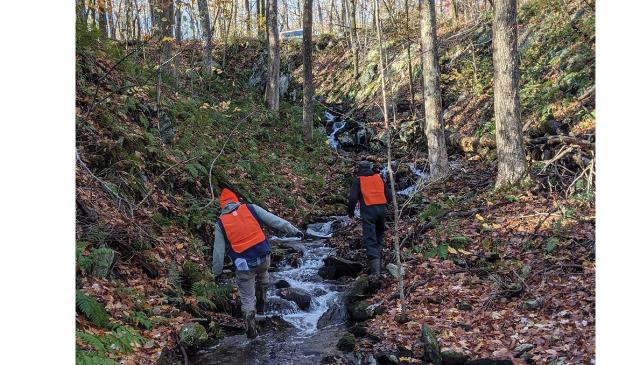Overview
The Commonwealth is already experiencing climate change impacts. Region-specific priorities reflect the unique hazards, natural and built environments, and demographics of each part of the Commonwealth. The Climate Assessment evaluated risks across seven regions:
- Berkshires and Hilltowns Region
- Greater Connecticut River Valley Region
- Central Region
- Eastern Inland Region
- Boston Harbor Region
- North and South Shores Region
- Cape, Islands, and South Coast Region
Volume III of the Climate Assessment includes a summary and full report on each region.
Share These Findings
Share findings about the Berkshires and Hilltowns region from the MA Climate Change Assessment with your community through the example social media content below:
Regional Context
The Berkshires and Hilltowns make up the state’s westernmost region, a mostly rural grouping of 55 cities and towns. The Berkshires and Hilltowns region has the smallest population among regions in this Climate Assessment and is characterized by natural resources. The region’s largest population centers are Pittsfield, home to nearly 30 percent of the region’s people, and North Adams. As in many parts of the state, healthcare and manufacturing are the largest industries, but tourism and agriculture also play a major role in the regional economy of the Berkshires and Hilltowns.
The Berkshires and Hilltowns region boundary used for this assessment matches the Municipal Vulnerability Preparedness (MVP) program’s Berkshires and Hilltowns region. Climate adaptation focus in the region is increasing, with all but a few communities having engaged in resilience and adaptation planning through the MVP program.
The most important climate hazards for the region include temperature extremes, changes in precipitation patterns, and consequent changes in the patterns of river flows, all of which affect the agriculture and natural resources of the area and can have impacts on the rural beauty that drives seasonal tourism and characterizes this region. Summer season temperature changes in particular may threaten the attractiveness of the region as both a haven from urban heat and an area with pristine recreational lakes (as elevated lake temperatures increase the risk of algal blooms).
Most Urgent Impacts - Human Sector
The Berkshires and Hilltowns region faces unique challenges in the Human Sector given the unique population distribution and development patterns in the region. Increase in Vector Borne Diseases Incidence and Bacterial Infections and Reduction in Food Safety and Security both are projected to produce high magnitudes of consequence (extreme and major, respectively), with disproportionate exposure. Minority and low-income populations are 14 to 16 percent more likely to be exposed to Lyme Disease within the region, compared to the rest of the population. In Massachusetts, the impact of climate change on food security is typically associated with food access in rural regions such as the Berkshires and Hilltowns. Here, local agricultural supplies and local economies are more heavily dependent on local food production. Additionally, food insecurity may also be linked to vulnerability of food distribution networks to extreme event risks.
Most Urgent Impacts - Infrastructure Sector
Precipitation and hydrological changes are projected to cause the most urgent impacts to infrastructure in this region. The Berkshires and Hilltowns region has a high risk for inland flooding when measured as a percentage of the total structure value in the region. The region is also expected to have the largest absolute annual economic impact of inland flooding in the Commonwealth by 2030 ($4.7 million annually). These economic damages attributed to climate change could double by 2090. Damage to Electric Transmission and Distribution Infrastructure is expected to increase over the century, with annual repair, capital, and operating cost increases due to climate change projected at $1.5 million by 2030 and $5.8 million by 2090. Clean water supply is also a critical issue in the region, particularly as compared the rest of the Commonwealth, as many households and businesses rely on groundwater supply which may become more unreliable. Damages to roads could pose the highest magnitude of consequence if current adaptation actions are not continued.
*Due to tied scores in the urgency rankings, the Infrastructure sector has three most urgent impacts for this region.
Read more about infrastructure sector impacts in the report.
Most Urgent Impacts - Natural Environment Sector
Natural resources play an important role in this region in terms of the abundance of natural areas compared to the rest of the Commonwealth, and connection of natural resources to the economy through tourism and agriculture. The Berkshires and Hilltowns region is home to the most miles of coldwater fisheries streams of any region in the Commonwealth. Coldwater species occurrence probability may decrease 42 to 77 percent by 2070. Forests cover over one million acres in the region. Climate change threatens to degrade ecosystem service flows from forests through habitat transition (driven by changing temperature and precipitation regimes) and increased mortality from pests, pathogens, and invasive species as well as more extreme weather (e.g., ice and wind storms). Adaptation to these impacts is ongoing, however the scale of resources in the region requires significant attention to adequately address these risks.
Read more about natural environment sector impacts in the report.
Most Urgent Impacts - Governance Sector
Climate impacts on governance are exacerbated in this region by the relatively small municipal operating budgets. Regional cooperation will be important for facing the challenges of climate change. The region could face significant costs as receivers of climate migrants from other areas of the Commonwealth (particularly areas at risk of sea level rise) and beyond. While new populations can bring benefits to receiving communities, the potential Costs of Climate Migration include specialized housing provision, both short-term and medium-term; social services; increased educational costs to school systems; and pressure on existing public infrastructure related to potentially abrupt population increases. Increase in Demand for State and Municipal Government Services, even for the existing population, is another impact with projected major consequences, with the potential for disproportionate exposure. For this region there could be increased need for MassHealth, food security support, and emergency response as a result of climate change. Many of these impacts can be expected to be concentrated among those residing in low-income block groups.
Most Urgent Impacts - Economy Sector
The current supply of affordably priced housing in the Berkshires and Hilltowns, already limited due to an influx of people during the pandemic, may be further strained by the need to house seasonal workers in the tourism and hospitality sector and by migratory pressures, especially among those who may now or in the future be moving away from climate risks (including wildfire, drought, coastal hazards, and extreme summer temperatures). The tourism industry is a key contributor to the Commonwealth’s economy, and in particular, to the economy in the Berkshires and Hilltowns region. The region has the highest tourism-related employment per capita of any region in the Commonwealth. The readily quantified losses to this industry are from loss of winter activities. At the same time, longer summer and shoulder seasons (i.e., spring and fall) could extend the high season for tourism for many destinations, although the timing of changing foliage colors and maple sugaring may become more unpredictable in the future, thus making it difficult to plan seasonal festivals other tourism draws. Environmental health stressors may decrease participation across activities—for example, increased aeroallergens, threats of vector borne disease, decreased air quality due to wildfires, in addition to extreme heat days in the summer.
Featured Adaptation Effort
Housatonic Stream Restoration for Regional Flood Resilience Project
Four communities (Lenox, Pittsfield, Stockbridge, and New Marlborough) conducted regional, community-wide assessments of approximately 400 culverts, and designed the replacement of three priority culverts. In partnership with the youth organization Greenagers, youth from Environmental Justice communities were trained and hired to conduct the assessments.
Quick links
- ResilientMass Homepage
- ResilientMass Site Map
- Massachusetts Climate Change Assessment
- Massachusetts Climate Change Assessment – Greater Connecticut River Valley Region
- Massachusetts Climate Change Assessment – Central Region
- Massachusetts Climate Change Assessment – Eastern Inland Region
- Massachusetts Climate Change Assessment – Boston Harbor Region
- Massachusetts Climate Change Assessment – North and South Shores Region
- Massachusetts Climate Change Assessment – Cape, Islands, and South Coast Region
- Massachusetts Climate Change Assessment – Regional Summary Volume III
- Massachusetts Climate Change Assessment – Regional Report Volume III
